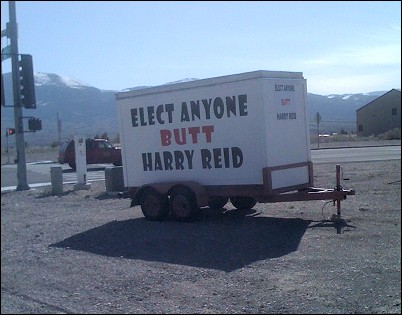Guest editorial by Ernest A. Canning
 In a May 3 New York Times editorial, "Drilling, Disaster, Denial," Paul Krugman points to a Gallup poll which found: "Americans are now less worried about a series of environmental problems than at any time in the past 20 years" --- a finding mirrored by surveys conducted by the Pew Research Center which revealed that the percentage of Americans who believe "there is solid evidence that the average temperature on earth has been getting warmer over the past few decades," had dropped from 71% in April 2008 to 57% in September/October 2009.
In a May 3 New York Times editorial, "Drilling, Disaster, Denial," Paul Krugman points to a Gallup poll which found: "Americans are now less worried about a series of environmental problems than at any time in the past 20 years" --- a finding mirrored by surveys conducted by the Pew Research Center which revealed that the percentage of Americans who believe "there is solid evidence that the average temperature on earth has been getting warmer over the past few decades," had dropped from 71% in April 2008 to 57% in September/October 2009.
After pointing to the catastrophic events --- the 1969 Santa Barbara oil spill and the fire atop a polluted Cuyahoga River --- which gave rise to the first Earth Day in 1970, the Clean Water Act and the Environmental Protection Agency, Krugman suggested that the success alleviating "visible pollution" that was involved in these "photogenic crises" led to reduction in public concern for the less visible impact "of pollution that's invisible, and whose effects unfold over decades rather than days" --- an invisibility which opened the way for hard-right, denialist, anti-environmental propagandists like Rush Limbaugh to succeed.
While there is empirical data supporting Krugman's suggestion of an adverse impact of anti-environmental propaganda, often funded by the likes of Exxon-Mobil and others in or connected to the fossil fuel industry, Krugman's analysis falls short because he fails to examine the role of the mainstream corporate media, especially television, in fostering the invisibility he decries...


 And Then They Came for the Judges...: 'BradCast' 4/28/25
And Then They Came for the Judges...: 'BradCast' 4/28/25 Sunday 'Desperation' Toons
Sunday 'Desperation' Toons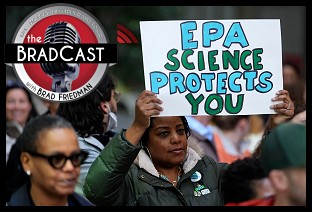 Trump EPA Guts Enviro Justice Office: 'BradCast' 4/24/25
Trump EPA Guts Enviro Justice Office: 'BradCast' 4/24/25 'Green News Report' 4/24/25
'Green News Report' 4/24/25
 Nation's Largest Broadcaster Hoaxes Viewers to Help Gut FCC Rules: 'BradCast' 4/23/25
Nation's Largest Broadcaster Hoaxes Viewers to Help Gut FCC Rules: 'BradCast' 4/23/25 Trump's FCC on Precipice of Ending All Limits on Corporate Control of Local TV Stations
Trump's FCC on Precipice of Ending All Limits on Corporate Control of Local TV Stations GOP Earth Day 2025 Hypocrisies and Dilemmas: 'BradCast' 4/22/25
GOP Earth Day 2025 Hypocrisies and Dilemmas: 'BradCast' 4/22/25 'Green News Report' 4/22/25
'Green News Report' 4/22/25 Pope Francis Dies, Trump Still Alive and Criming: 'BradCast' 4/21/25
Pope Francis Dies, Trump Still Alive and Criming: 'BradCast' 4/21/25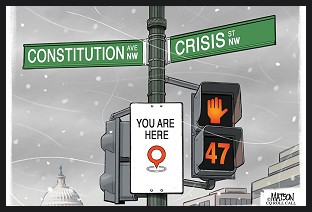 Sunday
Sunday  Sunday 'Zero Day' Toons
Sunday 'Zero Day' Toons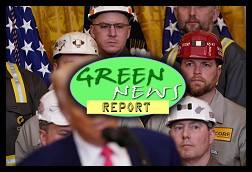 'Green News Report' 4/10/25
'Green News Report' 4/10/25 Soc. Sec. Expert Warns DOGE of Collapse, Privatization: 'BradCast' 4/10/2025
Soc. Sec. Expert Warns DOGE of Collapse, Privatization: 'BradCast' 4/10/2025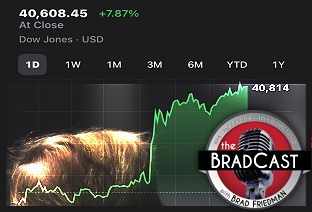 Trump Blinks, Chaos Reigns, Markets Spike Amid Tariff 'Pause': 'BradCast' 4/9/25
Trump Blinks, Chaos Reigns, Markets Spike Amid Tariff 'Pause': 'BradCast' 4/9/25 SCOTUS Deportation Ruling Grimmer Than First Appears: 'BradCast' 4/8/25
SCOTUS Deportation Ruling Grimmer Than First Appears: 'BradCast' 4/8/25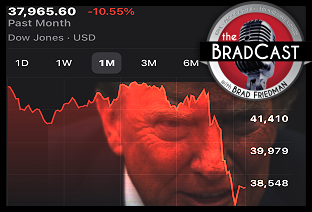 Cliff Diving with Donald: 'BradCast' 4/7/25
Cliff Diving with Donald: 'BradCast' 4/7/25 'Mob Boss' Trump's Trade Sanctions Tank U.S., World Markets: 'BradCast' 4/3/25
'Mob Boss' Trump's Trade Sanctions Tank U.S., World Markets: 'BradCast' 4/3/25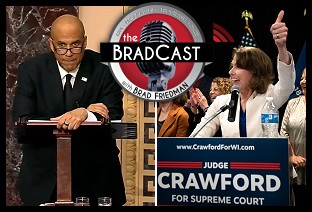 Crawford Landslide in WI; Booker Makes History in U.S. Senate: 'BradCast' 4/2/25
Crawford Landslide in WI; Booker Makes History in U.S. Senate: 'BradCast' 4/2/25 Judge Ends Challenge to GA's Unverifiable, Insecure Vote System: 'BradCast' 4/1/25
Judge Ends Challenge to GA's Unverifiable, Insecure Vote System: 'BradCast' 4/1/25 Bad Court, Election News for Trump is Good News for U.S.: 'BradCast' 3/31
Bad Court, Election News for Trump is Good News for U.S.: 'BradCast' 3/31
 VA GOP VOTER REG FRAUDSTER OFF HOOK
VA GOP VOTER REG FRAUDSTER OFF HOOK Criminal GOP Voter Registration Fraud Probe Expanding in VA
Criminal GOP Voter Registration Fraud Probe Expanding in VA DOJ PROBE SOUGHT AFTER VA ARREST
DOJ PROBE SOUGHT AFTER VA ARREST Arrest in VA: GOP Voter Reg Scandal Widens
Arrest in VA: GOP Voter Reg Scandal Widens ALL TOGETHER: ROVE, SPROUL, KOCHS, RNC
ALL TOGETHER: ROVE, SPROUL, KOCHS, RNC LATimes: RNC's 'Fired' Sproul Working for Repubs in 'as Many as 30 States'
LATimes: RNC's 'Fired' Sproul Working for Repubs in 'as Many as 30 States' 'Fired' Sproul Group 'Cloned', Still Working for Republicans in At Least 10 States
'Fired' Sproul Group 'Cloned', Still Working for Republicans in At Least 10 States FINALLY: FOX ON GOP REG FRAUD SCANDAL
FINALLY: FOX ON GOP REG FRAUD SCANDAL COLORADO FOLLOWS FLORIDA WITH GOP CRIMINAL INVESTIGATION
COLORADO FOLLOWS FLORIDA WITH GOP CRIMINAL INVESTIGATION CRIMINAL PROBE LAUNCHED INTO GOP VOTER REGISTRATION FRAUD SCANDAL IN FL
CRIMINAL PROBE LAUNCHED INTO GOP VOTER REGISTRATION FRAUD SCANDAL IN FL Brad Breaks PA Photo ID & GOP Registration Fraud Scandal News on Hartmann TV
Brad Breaks PA Photo ID & GOP Registration Fraud Scandal News on Hartmann TV  CAUGHT ON TAPE: COORDINATED NATIONWIDE GOP VOTER REG SCAM
CAUGHT ON TAPE: COORDINATED NATIONWIDE GOP VOTER REG SCAM CRIMINAL ELECTION FRAUD COMPLAINT FILED AGAINST GOP 'FRAUD' FIRM
CRIMINAL ELECTION FRAUD COMPLAINT FILED AGAINST GOP 'FRAUD' FIRM RICK SCOTT GETS ROLLED IN GOP REGISTRATION FRAUD SCANDAL
RICK SCOTT GETS ROLLED IN GOP REGISTRATION FRAUD SCANDAL VIDEO: Brad Breaks GOP Reg Fraud Scandal on Hartmann TV
VIDEO: Brad Breaks GOP Reg Fraud Scandal on Hartmann TV RNC FIRES NATIONAL VOTER REGISTRATION FIRM FOR FRAUD
RNC FIRES NATIONAL VOTER REGISTRATION FIRM FOR FRAUD EXCLUSIVE: Intvw w/ FL Official Who First Discovered GOP Reg Fraud
EXCLUSIVE: Intvw w/ FL Official Who First Discovered GOP Reg Fraud GOP REGISTRATION FRAUD FOUND IN FL
GOP REGISTRATION FRAUD FOUND IN FL




















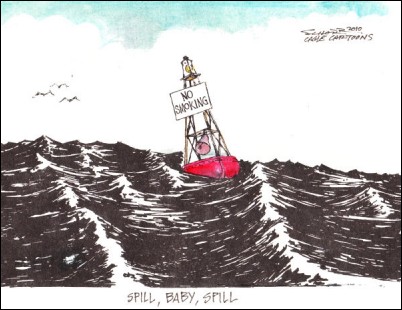
 I'm happy to jump in again to guest host the nationally syndicated
I'm happy to jump in again to guest host the nationally syndicated 


 There are no mistakes. As fate, or someone's idea of a joke would have it, I find myself, by complete coincidence, at the Creekside Inn in Northern California today, on totally unrelated work, on the first anniversary of the
There are no mistakes. As fate, or someone's idea of a joke would have it, I find myself, by complete coincidence, at the Creekside Inn in Northern California today, on totally unrelated work, on the first anniversary of the 

 Californians have been drawn within the cross-hairs of a propaganda blitz bought and paid for by
Californians have been drawn within the cross-hairs of a propaganda blitz bought and paid for by  Until then --- and until I'm finally back on the grid full time again --- here's a little musical "tribute" to that loser James O'Keefe III. You remember him, right? The guy who pulled off a scam, and then dressed up in a pimp outfit to
Until then --- and until I'm finally back on the grid full time again --- here's a little musical "tribute" to that loser James O'Keefe III. You remember him, right? The guy who pulled off a scam, and then dressed up in a pimp outfit to 

 I wonder why those who were so "outraged" about supposed ACORN corruption (even though it all turned out to be
I wonder why those who were so "outraged" about supposed ACORN corruption (even though it all turned out to be 